NVIDIA GeForce GTX 760 Review: The New Enthusiast Kepler
by Ryan Smith on June 25, 2013 9:00 AM ESTOverclocking GTX 760
Like the GTX 770 last month, the GTX 760 is clocked relatively high. Its 980MHz base clock is 65MHz higher than either the GTX 670 or GTX 660 Ti. As a result some of the overclocking headroom that we would expect has been eaten into by the overclock. Yet on the other hand the higher voltage for the highest boost bin – 1.2v versus 1.175v – gives us some additional overclocking headroom as long as our cooling can keep up.
At the same time the GTX 760 gets a slightly larger TDP adjustment window than most other GK104 parts. Here we can push the TDP up by up to 15%, from 170W to 195W. This is actually more than the GTX 770, so in TDP limited scenarios we should have a slightly easier time hitting the higher boost bins.
| GeForce GTX 760 Overclocking | ||||
| Stock | Overclocked | |||
| Core Clock | 980MHz | 1130MHz | ||
| Boost Clock | 1033MHz | 1183MHz | ||
| Max Boost Clock | 1149MHz | 1306MHz | ||
| Memory Clock | 6GHz | 6.5GHz | ||
| Max Voltage | 1.2 | 1.212v | ||
In practice GTX 760 ended up exceeding our expectations. In fact it even ended up exceeding GTX 770 with regard to the size of the overclock and the highest boost bin we reached. Altogether we were able to increase the core clock by 150MHz on our GTX 760 sample, going from a base clock of 980MHz to 1130MHz. At the same time our max boost clock went from 1149MHz to 1306MHz, making this the first Kepler we’ve seen to surpass 1300MHz. The end result is that core overclocking ends up being more potent than we were expecting.
Meanwhile the memory overclock is fairly standard for a GK104 part. It’s something of a roll of the dice, and in this case we were able to hit 6.5GHz before memory performance started regressing. Thus we’re altogether looking at a 15% core overclock coupled with a milder 8% memory overclock.
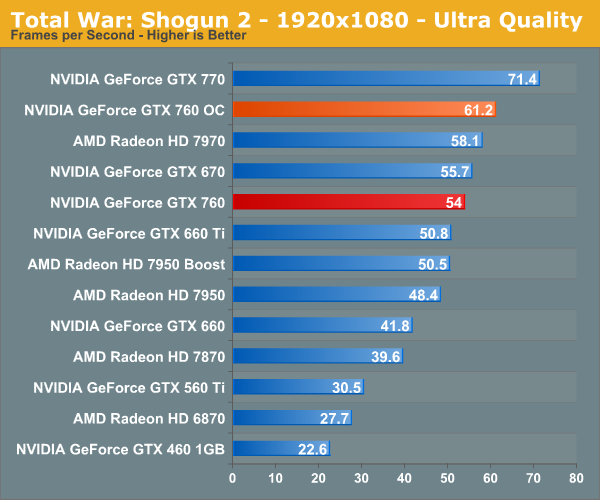
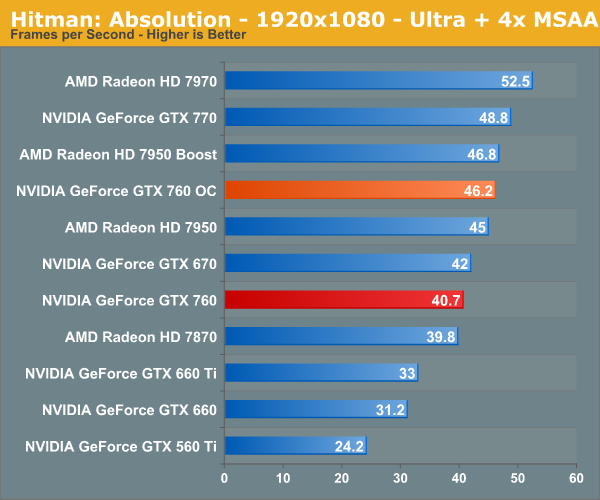
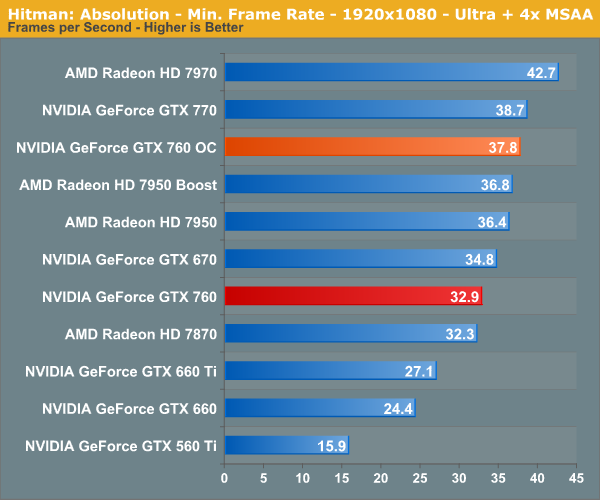
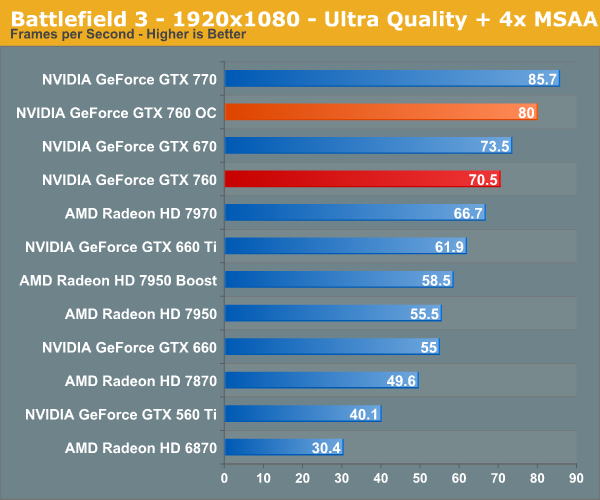
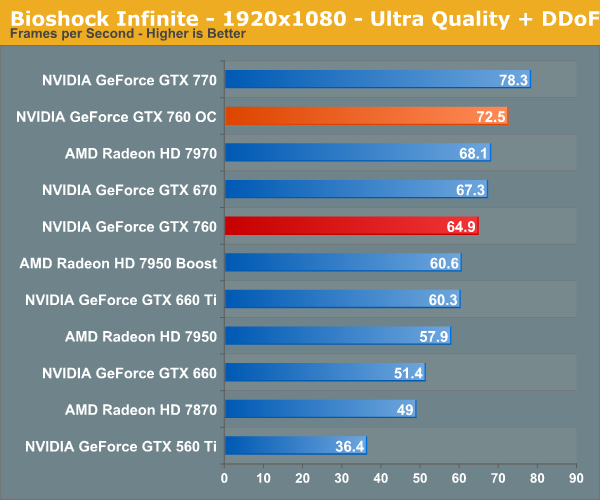
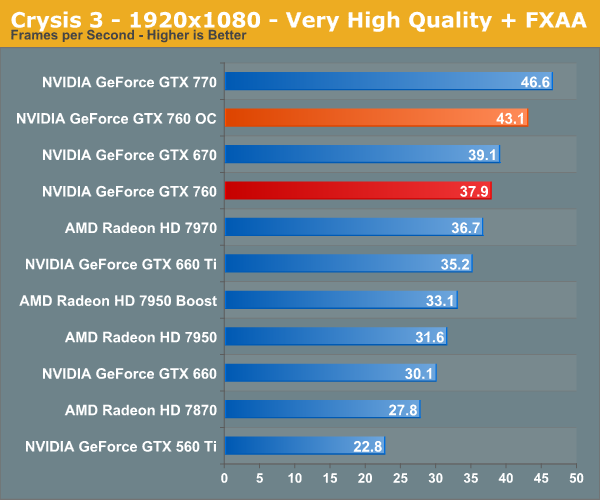
Given GTX 760’s base shader/texture performance deficit due to only having 6 SMXes, overclocking proves to be very effective on our final results. The performance gains in all 5 of our games were on the order of 12% to 14%, just a bit less than the core overclock itself. With the wide gap between the GTX 770 and GTX 760 in terms of specs this generally isn’t enough to completely catch up to NVIDIA’s top-tier GK104 card, but it can erase a large portion of the gap.
The end result of this overclock won’t dramatically change the GTX 760’s performance profile, but it should help to push it over 60fps in those situations where performance at 1080p at ultra quality settings was marginal. Or from a fixed performance standpoint, we’re approaching Radeon HD 7970 performance with this overclock.
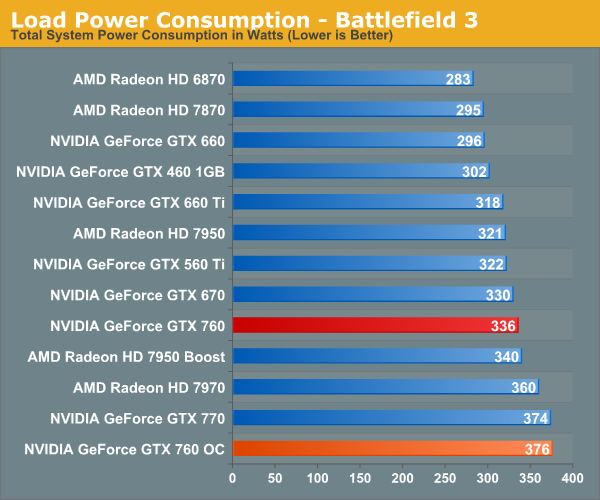
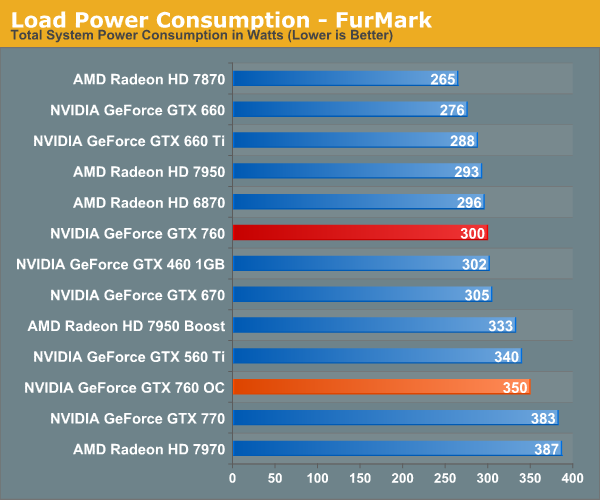
Moving on to power consumption, increasing our TDP has the expected hit. GTX 760 of course has a larger adjustment window than GTX 770, so the increase in power consumption ends up being noticeably larger. Overclocking in this manner pushes the GTX 760 off of the power/performance efficiency curve to some degree, so the GTX 760 loses its edge in that respect.
The end result is that power consumption at the wall jumps by 40W under BF3, and 50W under FurMark. This is tied with and better than the stock GTX 770 respectively, though as we’ve already seen it doesn’t match the GTX 770’s rendering performance. Furthermore as we’ll see, cooling is going to play a big factor here, with the reference GTX 760 cooler not always being the best choice for overclocking.
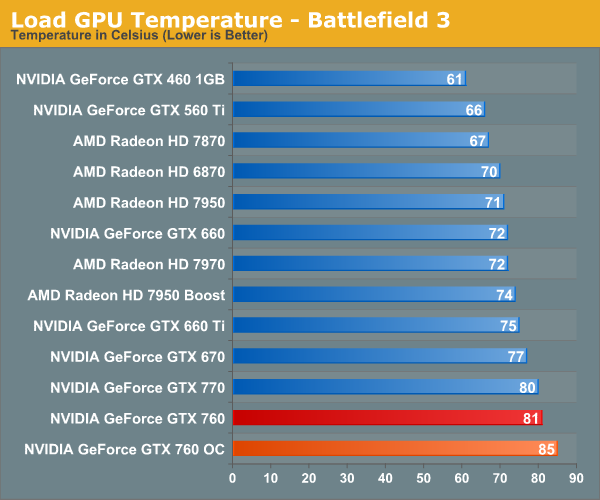
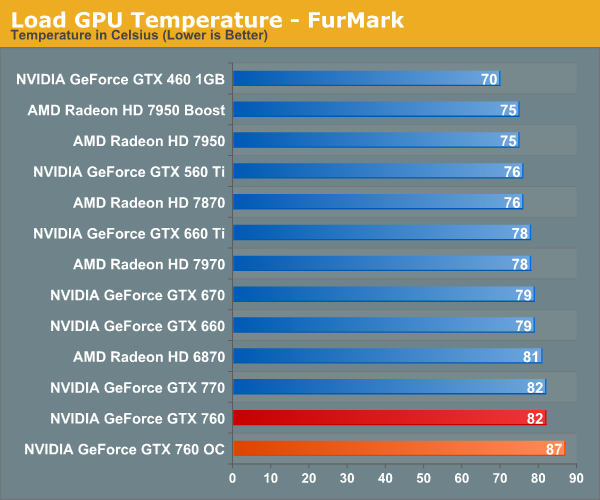
With the temperature limit raised to 95C, the reference GTX 760 cooler reaches equilibrium at 85C under BF3 and 87C under FurMark. These temperatures are still easily within spec for GK104, but they’re definitely starting to crawl up here. Meanwhile, though it’s not directly measurable the impact of leakage is certainly making itself felt here. If we had cooler temperatures power consumption would at least be marginally lower.
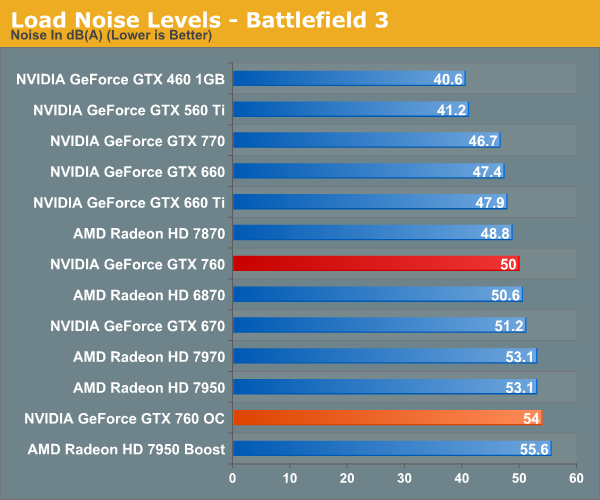
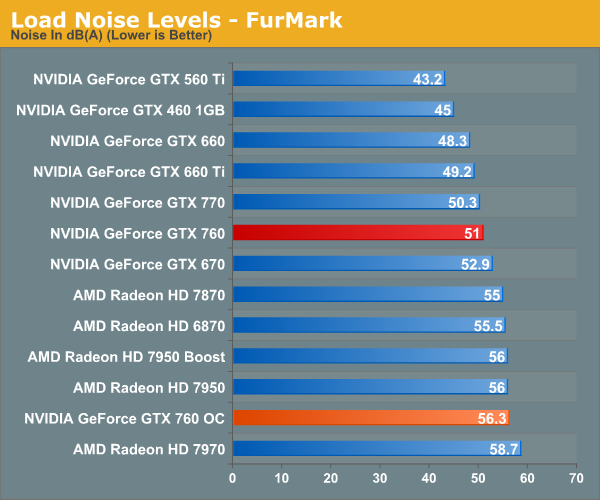
Finally we noise we can see that those new equilibriums also come at new, much higher noise levels. The reference cooler can keep up with the higher heat load created by overclocking, but it’s having to work hard to do so. These noise levels aren’t terrible – in fact they’re about even with the reference 7950 – but they do represent a real cost in terms of noise. Consequently, unlike NVIDIA’s Titan cooler that comes with the reference Titan, GTX 780, and GTX 770, when it comes to GTX 760 there’s very clearly room for improvement with custom coolers.










110 Comments
View All Comments
kishorshack - Tuesday, June 25, 2013 - link
Looks like the GPU gains over a two year cycle is more than CPU gainsSpending on GPU's is more worth while than Spending on CPU's
Specially if you start from Sandy Bridge in CPU's
DanNeely - Tuesday, June 25, 2013 - link
3D Rendering is a trivially parallelizable workload. As a result it can roughly double in performance with each full node process shrink just by keeping the core design the same but putting twice as many of them on the die. Real world behavior differs mostly in that some of the additional die space is used to enable things that weren't practical before instead of just making all the existing features twice as fast.wumpus - Tuesday, June 25, 2013 - link
That is only strictly true if you are willing to use twice as much electricity and generate/remove twice as much heat (it could approach costing twice as much as well, but not nearly as often). A good chunk of each update needs to go to making the GPU have a higher TFLOP/W or the thing will melt.ewood - Tuesday, June 25, 2013 - link
luckily many of those issues are mitigated by transition to a smaller process node, as DanNeeley said. your statement is more applicable to dual die cards, not new processors having twice the functional units.maltanar - Tuesday, June 25, 2013 - link
That is unfortunately no longer true, smaller processes do not benefit from the so-called 'Dennard scaling' anymore, without a lot of trickery from semiconductor engineers.DanNeely - Wednesday, June 26, 2013 - link
They may have to work harder at it; but as long as they're able to continue doing what you refer to as trickery, the result for us end users is the same.tential - Wednesday, June 26, 2013 - link
CPU gains have been made, just not in performance. We don't need performance on the CPU side for a LOT of applications. Like I always say, if you had double the CPU performance, you still wouldn't gain much FPS in most games.Intel would be cannibalizing it's higher end processors if it kept making CPU gains. Instead, it focuses on power consumption, to fit better CPUs into smaller things such as notebooks, tablets, etc. Look at the Macbook Air Review and then tell me we haven't made CPU gains.
UltraTech79 - Tuesday, July 2, 2013 - link
More worthwhile than what? What are you even talking about? Today's i5 chips arnt the bottleneck to any of the GPUs here in any game. So what you're saying is irrelevant.ericore - Tuesday, July 2, 2013 - link
Aint that the truth, the biggest change was from the 500 series to the 600 series.The 600 series make most radeons look like dinosaurs or AMD processors.
Intel is dicking around giving us less than 10% speed inprovement in each generation.
Can't wait for AMD to release their steamroller 8 core, except where latency is crucial it will match haswell and cost a fraction. Haswell will still technically be faster, but only in benchmarks, in practice they will be identical. The change from piledriver to steamroller is like from a a pentium 4 to a core 2 duo. It's not a new architecture, but has so many improvements that it ought to be called one.
MarcVenice - Tuesday, June 25, 2013 - link
I checked all the games, and the first 4-5 games the 7950 Boost wins, the other the GTX 760 wins. I didn't add up the numbers, but are you guys sure the HD 7950 Boost is 8% slower overall?And what's anandtech's stance on frametimes/fcat? Are those only used when problems arise, new games? I realize they take a lot of time, but I think they can be quite valuable in determing which card is the fastest.